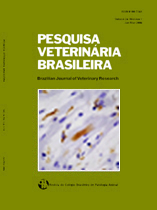 |
|
|
|
Year 2007 - Volume 27, Number 10
|

|
Experimental swainsonine poisoning in goats ingesting Ipomoea sericophylla and Ipomoea riedelii (Convolvulaceae), p.409-414
|
ABSTRACT.- Barbosa R.C., Riet-Correa F., Lima E.F., Medeiros R.M.T., Guedes K.M.R, Gardner D.R., Molyneux R.J. & Melo L.E.H. 2007. Experimental swainsonine poisoning in goats ingesting Ipomoea sericophylla and Ipomoea riedelii (Convolvulaceae). Pesquisa Veterinária Brasileira 27(10):409-414. Hospital Veterinário, CSTR, Universidade Federal de Campina Grande. Campus de Patos, 58700-000 Patos, Paraíba, Brazil. E-mail: franklin.riet@pq.cnpq.br
Ipomoea sericophylla and Ipomoea riedelii cause a glycoprotein storage disease in goats. This paper reports the experimental poisoning in goats by dried I. sericophylla and I. riedelii containing 0.05% and 0.01% swainsonine, respectively. Three groups with four animals each were used. Group 1 received daily doses of 2g/kg body weight (bw) of dried I. sericophylla (150mg of swainsonine/kg). Goats from this group had clinical signs 36-38 days after the start of ingestion. Group 2 received dried I. riedelii daily doses of 2g/kg of I. riedelii (30mg of swainsonine/kg) for 70 days. No clinical signs were observed, therefore the swainsonine dose was increased to 60mg/kg for another 70 days. Goats from Group 2 had clinical signs 26-65 days after increase in swainsonine dose to 60mg/kg. Group 3 was used as control. In these experiments the minimum toxic dose was 60mg/kg which represents 0.0004% of the dry matter in goats ingesting 1.5% bw of the dry matter. For goats ingesting 2%-2.5% bw of dry matter this dose would be 0.00024%-0.0003% of the dry matter. After the end of the experiment two goats were euthanized and another six were observed for recovery of clinical signs. Four goats that continued to consume swainsonine containing plant for 39-89 days after the first clinical signs had non reversible signs, while two goats that ingested the plant for only 15 and 20 days after the first clinical signs recovered completely. These and previous results indicate that irreversible lesions due to neuronal loss occur in goats that continue to ingest the plants for about 30 days after the first clinical signs. Clinical signs and histological lesions were similar to those reported previously for goats poisoned by swainsonine containing plants. No significant alterations were found in packed cell volume, red and white blood cell counts, hemoglobin and mean corpuscular hemoglobin concentrations, mean corpuscular volume, and serum levels of glucose, total protein, and albumin, and the serum activities of gamma glutamyl transferase and aspartate aminotransferase. Swainsonine concentration of 0.05% in I. sericophylla and 0.01% in I. riedelii are different from samples of these plants used in previous experiments, which contained 0.14% and 0.5% swainsonine, respectively, demonstrating a wide variation in the toxicity of different samples. |
| |
|
|
| |
|
 |